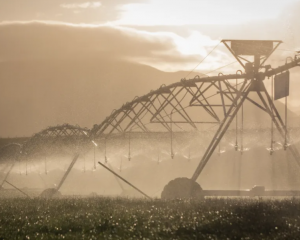
Tree tops started appearing on inshore margins at the south side of the lake near Fairlie when it was at 46% of its operating capacity in January after drought-like conditions from an El Nino summer. By March, irrigation was shut down after the lake dropped to the cut-off point of 373m.
For the past month it has been hovering around 390m with levels replenished from winter and spring rainfall and outgoing flows being managed.
Opuha Water Ltd chief executive Bjorn Triplow said the lake was looking much better than a few months ago and sitting nicely for environmental river flows, town supply, irrigation and power generation.
"So we are actually at 100% of our operational capacity in the lake. So the current lake level is sitting at 90% of its total volume, but we are 100% operational which is good for us."
He said the lake levels had been monitored and managed by the Opuha Environmental Flow Release Advisory Group (OEFRAG) including representatives from Arowhenua Runanga, Environment Canterbury, Fish & Game, the Department of Conservation, farmers and district councils.
OEFRAG had been looking at the river connection and flows closely since March with the mindset of getting the lake back to full.
"Over and above that we’ve also had a couple of rain events over the last couple of months that have also positively impacted on the lake level."
Irrigation was cut short last season by two to three weeks in March when lake levels reached the minimum operation level. There was still enough lake water at that stage for river flows, he said.
The man-made 700ha lake has additional water beyond operating levels to allow minimum flows into the Opihi River.
He said they were hoping for further recharge from the remainder of the snow melt in the lake catchment along the Two Thumb Range.
"That is setting us up well for the season."
An indication of the turnaround was Opuha Water making the most of rainfall and higher river flows earlier this month to release a surge of lake water into the Opuha River.
The "artificial fresh" was carried out to remove didymo in the river system.
Mr Triplow said they took advantage of the high rainfall event a few weeks ago to release water in the lower weir to remove river deposits of silt and the weed.
This was completed without detriment to the lake as it was above the operational level, he said.
He said weather forecasts were shaping up to be neutral between El Nino and La Nina at this stage.
"We are hoping that does prevail and we end up with a wetter season to give us that relief for a wetter summer than what we had previously."
Environmental flows had only reached the cut-off point of below 373m three times — including last summer — since the lake was built.
"That’s what the dam was put in there for — to prevent a drought scenario — so the dam itself performed as it was designed and prevented water restrictions in the Timaru township and the like and we were able to pretty much continue to irrigate right up to March and just fell slightly short. So it performed as it should have and we have only seen the lake go that low twice before."
He said the trees were well back below the surface from increased lake levels.
"We did take the opportunity to mark some of those so we know where those hazards are going forward. They are historic from when the dam was built originally. They probably won’t be there much longer as some of them weren’t looking that great at that stage."
The irrigation season normally starting in September was deferred to this month by the management group to give the lake an opportunity to be at full operational level. Farmer shareholders were in favour of this move, he said.
"We’re just now starting to see a little bit of demand. Two weeks into October we haven’t had a lot of irrigation going at this point. Even so, the ground soil moisture has been pretty good across the scheme."
The dam generates electricity for the national grid for about 4000 households and supplies water to 16,000ha of farmland.












